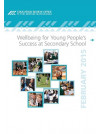This report presents the findings of ERO’s evaluation of how well 68 secondary schools in Term 1 2014 promoted and responded to student wellbeing.
Methodology
The overarching question for this national evaluation was:
To what extent do schools promote and respond to student wellbeing?
The evaluation involved 68 secondary schools in Term 1, 2014. The type of school, roll size and location (urban or rural) reviewed are shown in Appendix 1.
ERO’s judgement20 for each school was linked to ERO’s Wellbeing for Success: Draft Evaluation Indicators for Student Wellbeing (draft) 2013. The judgements were based on:
• the commitment and enactment of processes that promoted and responded to student wellbeing
• the inquiry processes that informed improved responses to wellbeing across the school, including processes for individual students with high wellbeing needs
• how well the learning, teaching and curriculum focused on improving wellbeing
• school leaders’ promotion of, and response to, student wellbeing
• the contribution to student wellbeing of school partnerships with parents and whānau, and with community health and social service providers.
Information used to make the judgement included:
• discussions with, and observing interactions among, students, parents and whānau, school leaders and teachers, guidance and counselling teachers, school social workers and nurses, and board members
• analysis of the school’s strategic documents, including plans for curriculum, professional learning and development (PLD), care for students, responses to traumatic events and minutes of meetings (especially about how the school used data about student wellbeing)
• analysis of Public Achievement Information (PAI), NCEA data, stand-downs, suspensions and exclusion data.
Individual students’ wellbeing could not be guaranteed in any school at any one time. Traumatic incidents, bullying and mental and physical health problems of students or significant members of their family or whānau affected an individual’s level of wellbeing, regardless of how focused a school was on student wellbeing. The important factors in making a judgement about each school were whether the school was prepared for such events and how evident the focus on student wellbeing was in the actions and documents associated with school culture, curriculum and systems.
Key Results
Principals in schools that were well-placed to promote and respond to student wellbeing had systems to ensure school values, curriculum and responses to wellbeing issues were designed in consultation with the school community. They also made sure that these systems were adequately resourced to be a key part of day-to-day practice and were regularly reviewed to monitor their effectiveness. These leaders understood that students needed opportunities to:
• develop relationships with peers and adults that were based on mutual respect
• learn and take risks in a safe environment
• develop goals and experience success
• develop leadership skills and a sense of their own ability
• be “confident, connected, actively involved, and lifelong learners.”36
Students at these schools said they felt supported by teachers and that they valued being treated as resourceful young adults. Even with this care, the key finding from this evaluation was that students in all schools were experiencing a very assessment driven curriculum and assessment anxiety.Achieving academic success is a part of wellbeing but is not the only factor. Very few schools were responding to this overload by reviewing and changing their curriculum and assessment practices. Schools need to explore the intent of NCEA and The New Zealand Curriculum (with the senior secondary guidelines) and develop a curriculum that is underpinned by the vision and principles of these documents.
Schools need to be assured that all students have opportunities to explore wellbeing issues. For most students, the health curriculum is only up to Year 10 and is no more than two hours a week. Schools need to map how wellbeing themes are taught across learning areas and year levels to determine whether all groups of students, because of the subject choices they make, have opportunities to explore wellbeing themes outlined in The New Zealand Curriculum.
Most schools, with their community, have developed a set of desired outcomes for students. By monitoring all of these outcomes, and not just achievement, schools would be better prepared to respond to the wellbeing needs of individual students and group of students.

